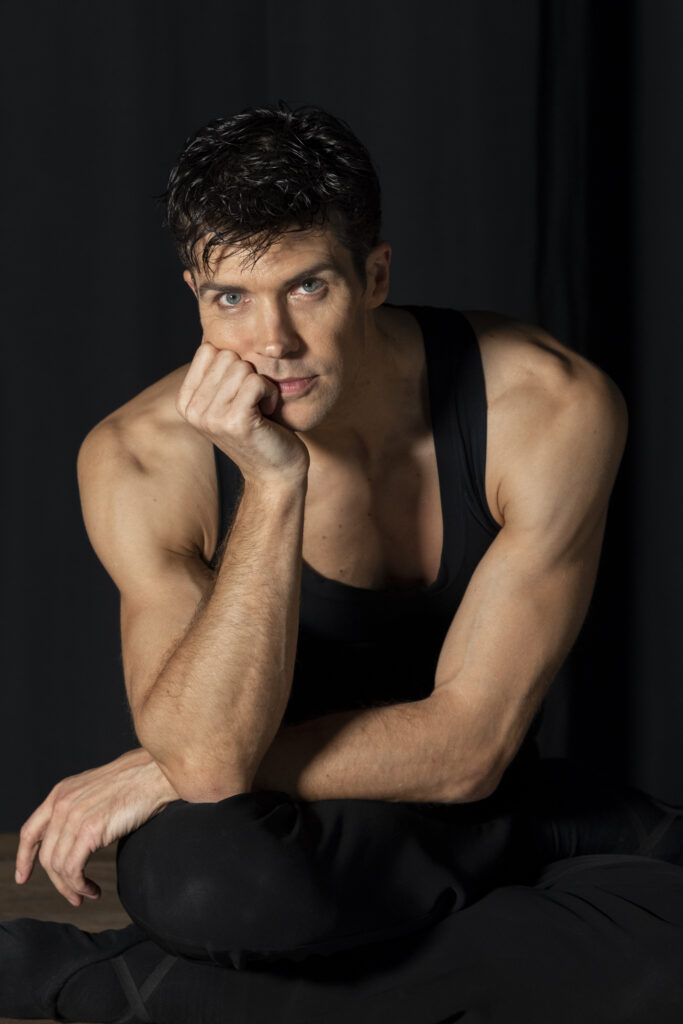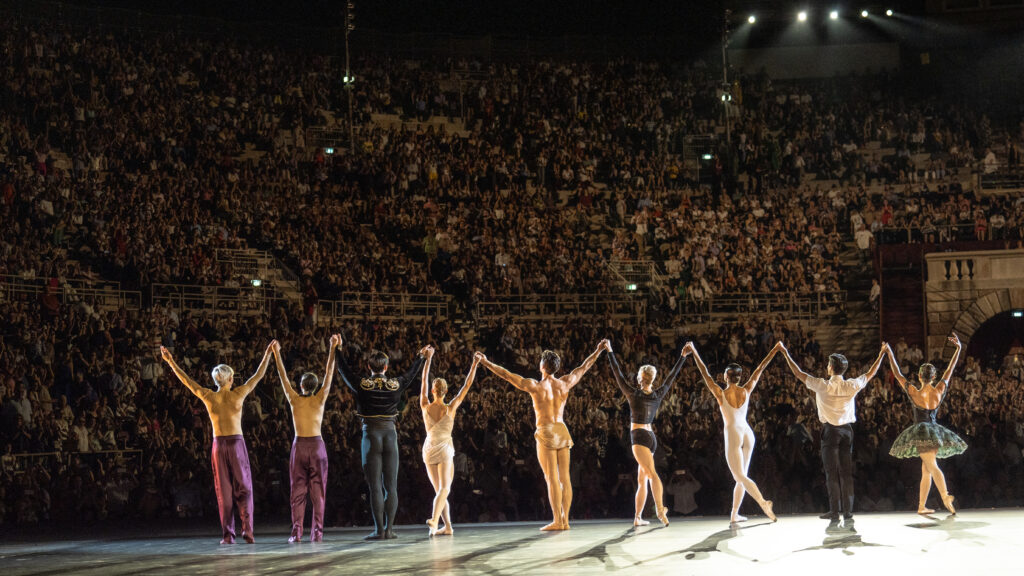An intimate look at the career of a dancer who never stops evolving

Interview by: Branislava Tomić
As The New York Times calls him, Ballet Superman, Roberto Bolle, will perform in Serbia for the first time as part of the 22nd Belgrade Dance Festival. The performance will take place on 16 March at the Sava Centre.
When you were a child, what drew you to dance?
I started dancing when I was very young. The reason was my best friend from nursery, who attended a ballet studio. She was always dancing. She would show me steps from her classes, and I would repeat them all. I was captivated by the music and often danced to the radio or in front of the television. In the end, when I was seven, my mother took me to that studio.
How did your ballet journey unfold?
I was born in a small town, Casale Monferrato, in northern Italy, where my first ballet school was located. We had classes twice a week. After a few years, I needed a more serious programme, so my mother enrolled me in a bigger school, half an hour’s drive from my hometown.
I was selected for the Ballet School of the Academy of Milan’s La Scala Theatre when I turned twelve. That was when I truly moved to the big city of Milan and, for the first time, was separated from my family, friends, and school. It was difficult. I suffered a lot during the first three years. At the same time, it was a great opportunity to be part of the finest educational institution and theatre—to live in the temple of ballet. That was the path I followed until I was nineteen when I received an engagement with the Ballet of La Scala Theatre.
And throughout all this time, did you have the support of your family?
They were never against me continuing to dance and progressing further. When I struggled with being away from home, they encouraged me to wait and see if dance was truly something I wanted to dedicate myself to. They taught me not to give up. Like other children in Italy, I also took piano lessons, went swimming, and had many other activities. However, dance gradually became the most important thing for me.
Ballet is incredibly demanding, and staying at the top requires immense discipline and sacrifice. But the applause and the audience’s love are my greatest reward
Who was your role model in the ballet world?
When I was fifteen, I met Rudolf Nureyev in Milan. At the time, he was working on a production of The Nutcracker for La Scala Ballet. That production was a key collaboration between the company and the school, as students participated in certain parts of the performance. From that moment, Nureyev became my role model. I was deeply impressed by his presence.
Your performances show clear emotions on your face. Did you take acting lessons?
During my training, I worked with twelve teachers who selflessly passed on their knowledge to me. At the age of twenty-one, I became a principal dancer. I began guest-performing with various companies, from the National Ballet of Canada and the Royal Ballet in London to the Paris Opera Ballet and American Ballet Theatre in New York.
When you have the chance to travel so much and work with so many different yet extraordinary artists, you naturally absorb a wealth of information and advice, which accelerates artistic growth. The opportunity to perform alongside Sylvie Guillem, Alessandra Ferri, Carla Fracci, and many other remarkable stars allowed me to constantly learn and evolve.
Do you prefer ballet or contemporary dance? Are there roles that are particularly dear to you?
If I have to choose, my answer is – being on stage! However, performing in contemporary productions has allowed me to be more than just a performer. Classical ballet is beautiful to watch. It is highly elegant and demands perfection. However, for the artist, it is a restrictive form with little room to express emotions or personal interpretation. Everything must be exact, like mathematics. In contemporary dance, there are countless ways to express ourselves to show moods, ideas, goals, and emotional states. A new level of expression and interpretation emerges. For us classical dancers, discovering that freedom is an incredible experience.
 You have had an incredible career, performing with the most renowned ballet companies in America and Europe. Do audiences respond differently in various parts of the world?
You have had an incredible career, performing with the most renowned ballet companies in America and Europe. Do audiences respond differently in various parts of the world?
The system differs between America and Europe. I was a principal dancer with New York’s American Ballet Theatre (ABT) for fourteen years. That famous company does not have its own theatre, meaning that as a dancer, you step straight from the rehearsal studio onto the stage. The cost of theatre rental is too high to afford the luxury of rehearsing in the actual performance space. We have beautiful theatres in Italy and across Europe, and our companies are integrated into these institutions, meaning the stage is ours. There is also government and institutional support for the arts in Europe, which does not exist in the US. In America, everything is far more challenging, and for me, the experience of being there and performing with ABT was truly significant.
You have performed in many countries and at events ranging from the Sanremo Festival to fashion shows for Dolce & Gabbana and in front of some of the most famous figures of our time. How do those performances compare to performing in a theatre?
Those moments sometimes bring more stress than performing on a theatre stage. For example, I performed at Her Majesty Queen Elizabeth’s birthday celebration, which was broadcast live across hundreds of television channels worldwide. I also performed at the opening ceremony of the Winter Olympics—again, live.
When something is broadcast on television, the pressure is entirely different. Even the smallest unexpected issue can disrupt everything in front of millions of viewers. Additionally, just like at the Winter Olympics, the stage and conditions are often not ideal for dancing. It was the middle of winter, and we were outdoors in freezing temperatures. Some areas of the stage were covered in ice. If you step on a frozen patch, you could slip and fall—in front of the entire world.
If an artist can convey emotion and the audience can feel it—just as I, as an artist, feel their emotion—then we have achieved what we strive for
You are a symbol of Italian ballet and have been at the top of the global scene for a long time, much like our tennis player, Novak Djokovic. What motivates you to stay among the best?
Ballet is incredibly demanding, which makes it very difficult to stay at the top. It requires immense discipline and dedication. You must make sacrifices—give up significant parts of your personal life—if you want to pursue this profession seriously. Ballet is my passion, something I love doing.
Of course, I make a living from my work, and I am fortunate to still be part of incredible projects and performances, appearing on television and in beautiful theatres. I push myself to the limits of endurance because, to dance, I must train continuously and maintain discipline in everything. For example, I have never taken a holiday longer than five days! While all my friends enjoy the seaside in summer, I have to return to the ballet studio after five days. The applause and the audience’s love are my greatest reward.
You often work with young dancers and are a UNICEF ambassador. How do you find the time and motivation for everything alongside your performances?
I have always wanted to do more than just perform on stage. I realised that this way, I could contribute to my art. My goal is to bring ballet closer to a wider audience. That’s why I created the gala concept, Roberto and Friends. At first, we performed in smaller theatres across Italy, but the production became so popular that we started performing in arenas, colosseums, and concert halls with thousands of seats. We have reached millions of people.
That was when I began to understand how important it is to attract media attention and gain public recognition. I performed on television, acted in films, series, and shows—young people started seeing me as a role model. This led to my involvement with UNICEF, and I traveled to Africa to help children. That inspired me to do even more, so I founded a foundation for young ballet dancers. Its goal is to give opportunities to those who lack the resources I have.
Seven years ago, we created an event in Milan to celebrate dance. Every year, in front of Milan Cathedral, thousands of children participate in a ballet class broadcast on television. Ballet is an art form that plays a crucial role in growing up. Beyond teaching aesthetics, it instils ethics and discipline—the hard work behind every achievement that we, as human beings, admire. It teaches perseverance and the significance of small daily accomplishments. When children learn the value of hard work from an early age, they can grow into individuals with the potential to make a difference in their lives and communities. That is what ballet offers!
What can the Belgrade audience expect from your performance? What are you bringing to Sava Centre?
I am very excited to come to Belgrade at the invitation Aja Jung, whose festival I have heard so much about. This will be my first time in Serbia—I have never been here before! I am bringing a performance featuring the brightest stars of today’s ballet scene. One of them is the incredible Nicoletta Manni.
If this is someone’s first time watching a ballet performance, I guarantee they will become a devoted fan! And for those who are already ballet lovers, we will bring something new and unforgettable—a theatrical experience of the highest quality. True quality is always recognisable regardless of how much one knows about art. If an artist can convey emotion and you, as the audience, can feel it—just as I, as an artist, feel your emotion—then we have achieved what we strive for.